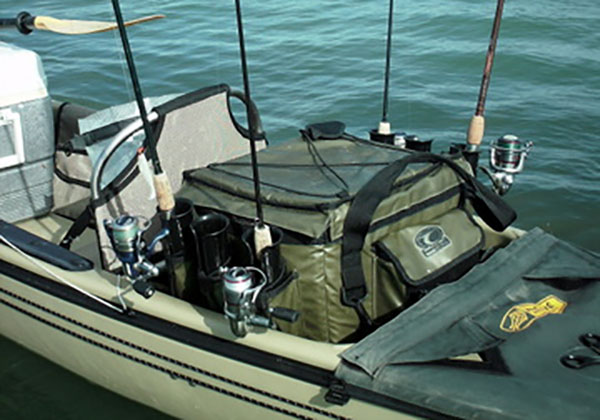November 18, 2014
By Neil Taylor, www.strikethreekayakfishing.com and www.capmel.com

I usually talk about “the merits of the dry bag” in my seminars, particularly for those who are new to the paddling sports. Those who are veterans to paddle sports and water figured out the merits of the dry bag the hard way, are pleased to be alive to talk about it. This one is just so simple. If you don’t have these, go and get one or more of them. This is just too easy and inexpensive and will not only save you money on valuables not lost, it is something that can be critical if you are in challenging situations and access to sensitive electronic equipment is your contact with civilization. The “merits of the dry bag” paramount lesson: It only works if you seal it. Regularly people will tell me stories of lost gear because they did not clip seal their dry bag. Just make it a habit. The only time you should have it open is when you are actively removing an item. Close it when you have the item. Close and seal it again after you return that item to the bag.
Common sense and survival of the fittest: This product exists. Owning dry bags is comparable to holding an any-uses “Get out of Jail Free” card. If you want to carry your cell phone in your pocket without a waterproof case around it, roll the dice. If you make one simple mistake and forget or there is some other happenstance: You may be out a phone. Not just a phone, anything that is prone to ruination from water is a candidate to reside in a dry bag.
Question: Safety: the cell phone, which may be your best access to assistance other than a VHF radio (channel 16 is emergency) wouldn’t you want to keep your phone dry and ready to use if you need it? Can you still make it back without being able to talk to someone first? Sure you can but I do not like losing my ability to call for assistance if something unusual comes up.
On cell phones, today’s phones there are great individual cases for your phone that can make it where you can still use the device, including the camera function. This eliminates errors you can make where you lose a phone “you took out of your main dry bag.” These days, the “dry case” specific to the phone is a better option than “the phone in the dry bag.” Tip: Incorporate a lanyard. If you have a clip to attach the phone to you, then have the dry case/phone in your shirt pocket, should it fall out of your pocket, it isn’t laying somewhere unknown to you or it doesn’t sink to the bottom of the ocean.
The handheld VHF radio is another “contact with civilization” item and are usually waterproof of submersible but Aqua Pac makes a pouch dedicated to the VHF radio and will extend the life of your unit.
What else is in the contents of the dry bag? I keep some batteries, my fishing license, wallet, car keys and even my camera if it is not in my pocket. My cell phone has a first class camera and I may pull it out of the dry bag for certain situations. You can put anything you want in there. Some people will devote one small dry bag for a First Aid Kit.
I would not put anything liquid in here, unless it is in its own package where it can’t leak on everything else. On that note, batteries can leak so I take them out of the packaging and put them in “pill bottles” which if there is an incident, confines the acid. I keep a lens cloth to clean my sunglasses in there as well, something I utilize regularly and has been a great asset for getting the spots off of the lenses.
Options and ideas for choosing dry bags. The concept is not new and the options are plenty. I have my own favorites from over the years. Different bags have different purposes.
Aqua Pac, a Captain Mel Classic sponsor, has many items to choose from. TheOtter Box is a hard-case choice. The Seal Line Baja Bag is a great one that I have enjoyed for years. The kayak shops have their own rebranded models with their logos on them and these are all quality dry bags. Over time and heavy use, watch for areas of stress and replace a bag that looks like it is wearing out. This should be rare. My dry bags with daily use last for years.
Common sense in play: The only time your dry bag should be open is when you are removing an item or when you are putting an item back in. One simple “fold and click” and the bag is secured even for the short periods of time you are using an item. Air sealed inside that also means it will float (and be more visible) if you are ever separated from your dry bag.
Open your wallet. Don’t lose expensive items because of bad decisions. Bad options? Zip Lock bags. I was that guy a long time ago, luckily before I carried anything that was very valuable. Buy a dry bag for less than twenty bucks and use it for years.
Dry storage is not just for the electronics or other valuables. It isn’t necessary most of the year in Florida but for several months it is and for kayak anglers and boat anglers across the world, oversize dry bags are crucial for carrying extra jackets and spare clothes in cold conditions. If you get soaked on a very cold day and need to change out clothes to fight off hypothermia, the dry bag with the extra set of clothes/jacket could be a real asset. Laid away somewhere even though you may not use it: Why not? Those items dry and clean can sit in hibernation until those times where you really need them.
These are top quality products, affordable and something that will keep you out of trouble and provide you with some backup insurance in certain situations. Come up with your own plan on what to put in dry storage and enjoy the extra peace-of-mind during your outdoor adventures.
Outdoor stores carry this item. Locally, Bill Jackson’s in Pinellas Park has one who section of the kayak accessory department devoted to dry bag and case options.
Neil Taylor
Owner and guide: www.strikethreekayakfishing.com
(Cell) 727-692-6345 LivelyBaits@aol.com
Owner and site administrator: www.capmel.com
- The Neil Blog… - July 26, 2023
- The Catfish - July 26, 2023
- update - July 22, 2023











